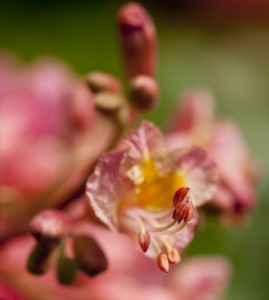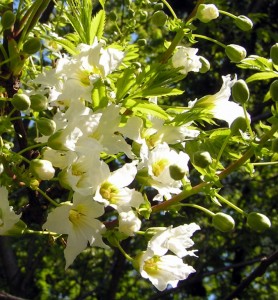Yellowhorn and Red Horse Chestnut
Posted in Gardening Tips on May 28 2014, by Sonia Uyterhoeven
Sonia Uyterhoeven is the NYBG’s Gardener for Public Education.

When I was a kid, I used to collect buckeyes or horse chestnuts, shine them and keep them in my pocket for good luck. The large, shiny nuts were a perfect treasure for a kid, and there is a centuries-old tradition that a buckeye in your pocket is a sign that good luck is on its way. The nickname “buckeye” comes from the Native Americans who thought the nut resembled a deer’s eye. My mother went to college in Ohio and my grandparents were from western Pennsylvania, so the common name buckeye was used in my household instead of horse chestnut.
Horse chestnuts are delightful in autumn, when the large nuts litter the ground beneath the trees after the prickly, globe-like husks split open to reveal the treasure inside. Equally intoxicating are the statuesque flowers of the horse chestnut in spring. These great spires of red, pink, or white flowers appear in late spring and liven up the landscape.
Recently, I was admiring a beautiful hybrid red horse chestnut called ‘Briotii’ (Aesculus × carnea ‘Briotii’). The 10-inch flower panicles on this horse chestnut are a rosy red with a yellow eye. ‘Briotii’ is a hybrid between the red buckeye (Aesculus pavia) and the European horse chestnut (Aesculus hippocastanum). It is a compact tree reaching somewhere in the range of 25 to 35 feet tall.
‘Briotii’ has dark green, palmate compound leaves that generally look good late into the season. Many horse chestnuts are susceptible to leaf scorch (burned margins of leaves from dryness), leaf blotch (fungal), and powdery mildew. ‘Briotii’ has a better resistance to fungal problems than its parents. As with all horse chestnuts, while it loves full sun, it is best to avoid planting this tree in a hot, dry location.

In the vicinity of ‘Briotii’, I spotted yellowhorn or the Chinese flowering chestnut (Xanthoceras sorbifolium). Our specimen is more the size of a tall flowering shrub than a small tree. Yellowhorn can be grown as a multi-stemmed shrub that will reach around 10 feet tall or a small flowering tree that can grow to 20 feet. The leaves are pinnate compound arranged in a feather-like manner along the stem.
The flowers appear in May, just before the leaves unfurl. Clusters of white flowers are held on 9-inch racemes. The 5-petaled flowers look like stars. At the base of the pristine white petals are luscious yellow centers that morph to red as they age. Round or pear-shaped fruit follow the flowers, containing pea-sized, purplish-brown seeds.
While the Chinese yellowhorn and the European and American horse chestnut are closely related, there are important differences. Once established, the yellowhorn is fairly drought resistant. The seeds in its funny fruits are also edible and used in Chinese cooking, whereas the buckeye or the horse chestnut is inedible and contains a poisonous alkaloid. What they have in common, however, is extraordinarily interesting: a beautiful spring bloom.
Xanthoceras sorbifolium image courtesy of Wikimedia Commons.

